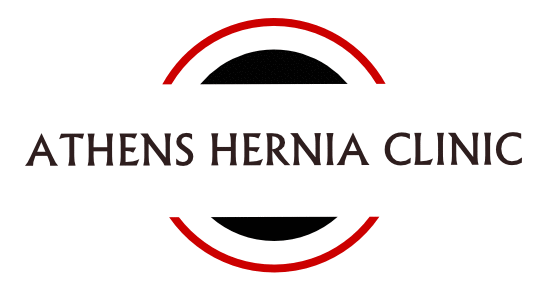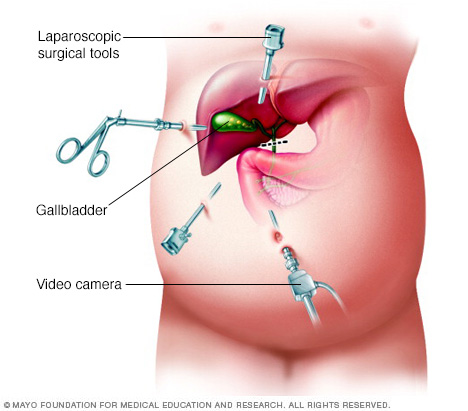Gallbladder Surgery
Gallbladder removal is one of the most commonly performed surgical procedures in the United States. Gallbladder surgery is almost always performed laparoscopically. The medical name for this procedure is Laparoscopic Cholecystectomy.
What is the Gallbladder?
- The gallbladder is a pear-shaped organ that rests beneath the right side of the liver.
- Its main purpose is to collect and concentrate a digestive liquid (bile) produced by the liver. Once bile is made by the liver, it is stored in the gallbladder. When you eat, the stomach sends a signal to the gallbladder. The gallbladder contracts, bile is expelled and moves down the main common duct to enter the intestine. Once there, bile mixes with food, aiding in digestion.
- Removal of the gallbladder is not associated with any impairment of digestion in most people
What are Gallstones made of?
Gallstones are small, pebble-like substances that develop in the gallbladder. The gallbladder is a small, pear-shaped sac located below your liver in the right upper abdomen. Gallstones form when liquid stored in the gallbladder hardens into pieces of stone-like material. The liquid—called bile—helps the body digest fats. Bile is made in the liver, then stored in the gallbladder until the body needs it. The gallbladder contracts and pushes the bile into a tube—called the common bile duct—that carries it to the small intestine, where it helps with digestion.
Bile contains water, cholesterol, fats, bile salts, proteins, and bilirubin—a waste product. Bile salts break up fat, and bilirubin gives bile and stool a yellowish-brown color. If the liquid bile contains too much cholesterol, bile salts, or bilirubin, it can harden into gallstones.
The two types of gallstones are cholesterol stones and pigment stones. Cholesterol stones are usually yellow-green and are made primarily of hardened cholesterol. They account for about 80 percent of gallstones. Pigment stones are small, dark stones made of bilirubin. Gallstones can be as small as a grain of sand or as large as a golf ball. The gallbladder can develop just one large stone, hundreds of tiny stones, or a combination of the two.
Why did I get Gallstones?
No one knows exactly why people get gallstones. We know there are certain risk factors for developing gallstones. They are:
- women—especially women who are pregnant, use hormone replacement therapy, or take birth control pills
- people over age 60
- American Indians
- Mexican Americans
- overweight or obese men and women
- people who fast or lose a lot of weight quickly
- people with a family history of gallstones
- people with diabetes
- people who take cholesterol-lowering drugs
Do you need your Gallbladder?
You gallbladder is a storage device, essentially a reservoir, designed to concentrate bile, which is produced by your liver. When you eat, the gallbladder contracts, and pushes out its stored bile into your intestine. The bile helps dissolve the fatty component of foods. Without your gallbladder, your liver will still produce bile but it will no longer be stored in the gallbladder. The bile will constantly slowly enter your intestine.
Fortunately, the gallbladder is an organ people can live without. Your liver produces enough bile to digest a normal diet. Once the gallbladder is removed, bile flows out of the liver through the hepatic ducts into the common bile duct and directly into the small intestine, instead of being stored in the gallbladder. Because now the bile flows into the small intestine more often, softer and more frequent stools can occur in about 1 percent of people. These changes are usually temporary, but talk with your health care provider if they persist.
What causes Gallbladder Problems?
- Gallbladder problems are usually caused by the presence of gallstones: small hard stones consisting primarily of cholesterol and bile salts that form in the gallbladder.
- It is uncertain why some people form gallstones. There are certain risk factors. They are commonly referred to as the four Fs: Females, Forty, Fertile, and Fat. Thus, gallstones tend to form in women, during pregnancy, with weight gain, and as people age.
- There is no known means to prevent gallstones.
- Many people discover that they have gallstones during tests for other medical conditions. Gallstones that are not and have not cause symptoms or problems generally do not need to be removed.
- Gallstones can cause symptoms in many ways :
- when they block the block the flow of bile out of the gallbladder, the gallbladder swells which can result in:
- Sharp abdominal pain (usually below your liver on the right upper side of your belly or just below your breast bone)
- Pain may also be felt in your back or right upper shoulder
- Bloating and / or abdominal distension
- Nausea and / or vomiting
- Indigestion
- If the gallstone becomes lodged, an infection can result
- Fever and severe abdominal pain will result along with the above symptoms
- Stones can also lodge and block the main common bile duct resulting in jaundice, a yellowing of the skin
- Stones can also irritate the pancreas and lead to pancreatitis
Minimally invasive (laparoscopic) cholecystectomy
During a laparoscopic cholecystectomy, the surgeon makes four small incisions in your abdomen. A tube with a tiny video camera is inserted into your abdomen through one of the incisions. Your surgeon watches a video monitor in the operating room while using surgical tools inserted through the other incisions in your abdomen to remove your gallbladder.
Next you may undergo an imaging test, such as an X-ray or ultrasound, if your surgeon is concerned about possible gallstones or other problems in your bile duct. Then your incisions are sutured, and you’re taken to a recovery area. A laparoscopic cholecystectomy takes one or two hours.
A laparoscopic cholecystectomy isn’t appropriate for everyone. In some cases your surgeon may begin with a laparoscopic approach and find it necessary to make a larger incision because of scar tissue from previous operations or complications.
Traditional (open) cholecystectomy
During an open cholecystectomy your surgeon makes a 6-inch (15-centimeter) incision in your abdomen below your ribs on your right side. The muscle and tissue are pulled back to reveal your liver and gallbladder. Your surgeon then removes the gallbladder.
The incision is sutured, and you’re taken to a recovery area. An open cholecystectomy takes one or two hours.
After a cholecystectomy
You’ll be taken to a recovery area as the anesthesia drugs wear off. Then you’ll be taken to a hospital room to continue recovery. Recovery varies depending on your procedure:
- Laparoscopic cholecystectomy. People are often able to go home the same day as their surgery, though sometimes a one-night stay in the hospital is needed. It takes about a week to fully recover, but will have lifting restrictions for 2-3 weeks.
- Open cholecystectomy. Expect to spend two or three days in the hospital recovering. Once at home, it may take four to six weeks to fully recover.
Low Fat Diet for Gallbladder
The gallbladder diet focuses on lean meats, low fat dairy products, and fruits and vegetables. Because fat cannot be digested normally, it is important to include plenty of fiber in the diet. A person with gallstones should add starchy foods to the diet, such as bread, to ensure adequate fiber consumption. This diet should be used until gallbladder surgery and maintained for two weeks after surgery.
Essentially, the gallbladder diet follows a typical food pyramid, with vegetables, fruits, and grains making up the bulk of the diet, supplemented by low fat dairy products and lean meats in moderation, and with fats and sweets relegated to “sparing” usage.
Foods to Avoid
For many who suffer from gallbladder disease or stones, a low fat diet is recommended to prevent complications. Foods to avoid include:
- Alcohol
- Animal fats
- Eggs
- Fried foods
- Greasy foods
- Pickles
- Processed and denatured foods
- Products made with sugar
- Products made with coffee
- Products made with spices
- Red meat
- Refined carbohydrates
- Whole or 2% Milk
- Cheese
- Butter
- Mayonnaise



